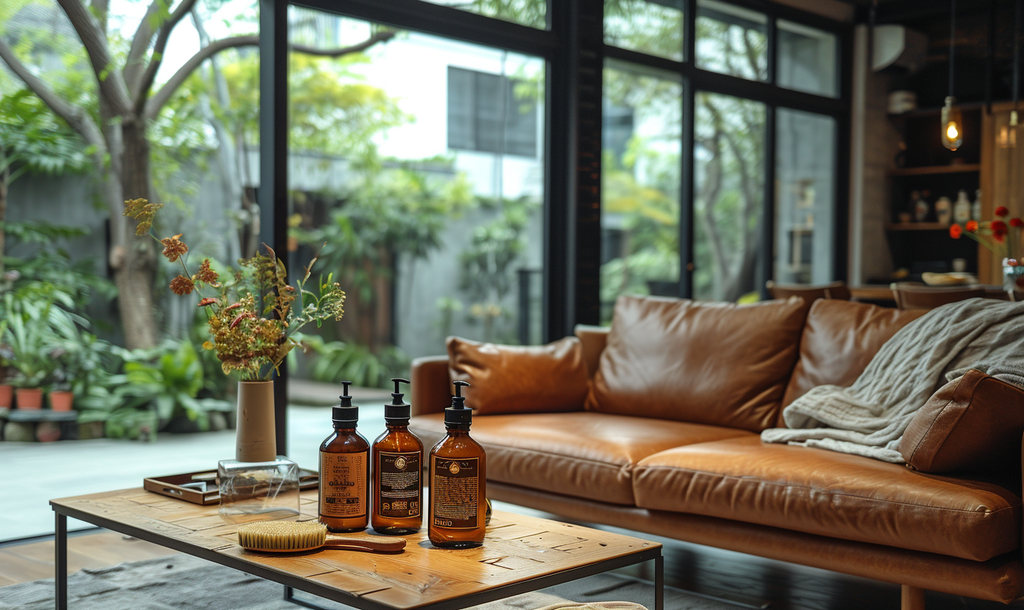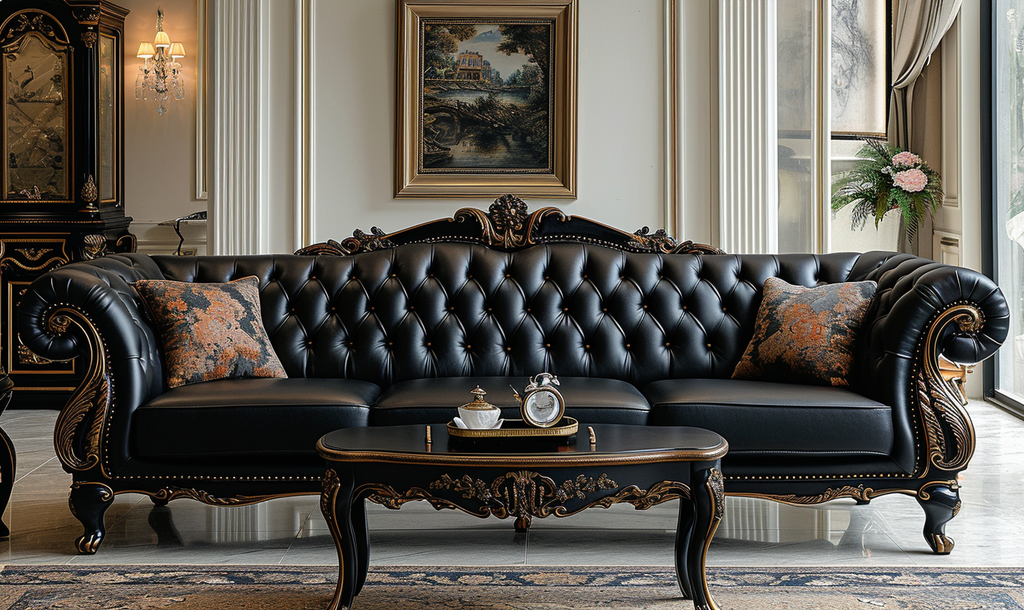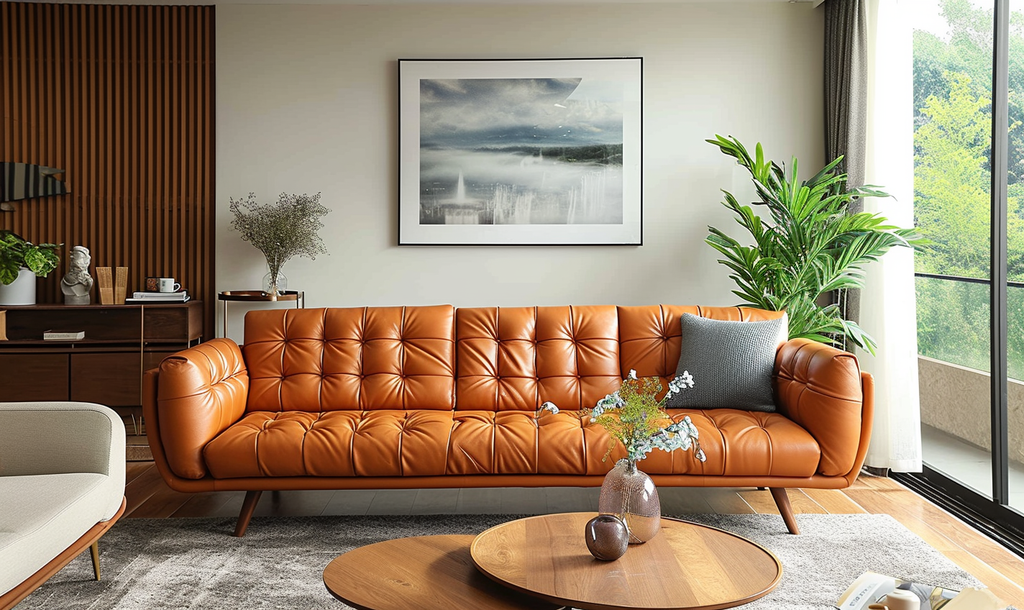Introduction:
In the realm of interior design, leather sofas stand as timeless icons, blending elegance with enduring resilience. This guide unravels the art of caring for your leather sofa, transforming routine maintenance into a curated experience. As we explore the nuances of this process, our journey begins with understanding the diverse types of leather – from the unaltered surface of full-grain leather to the balanced appeal of top-grain, and the distinct qualities of split-grain and bonded leather. Armed with this knowledge, you embark on a journey to curate a cleaning approach tailored to the unique needs of your cherished piece.
Our exploration continues as we delve into the essential tools and products – the artisans in the craft of leather care. From gentle cleaning agents to soft brushes and cloths, each element is meticulously chosen to enhance, not compromise, the natural beauty of your sofa. As we transition into the step-by-step cleaning process, we emphasize the significance of regularity, stain prevention, and deep cleaning rituals to rejuvenate your leather masterpiece.
This guide is not merely a manual; it's an invitation to elevate your leather sofa care. It urges you to embrace knowledge, curate your cleaning arsenal, establish intentional rituals, and confront challenges with confidence. By being proactive with preventive measures, considering professional expertise, and connecting with the leather community, you transform leather care into an art form. Your leather sofa, a symbol of timeless beauty, deserves nothing less than the curated attention and intentional care outlined in this guide – ensuring it continues to grace your living space with elegance and resilience for generations to come.

Understanding Leather Types
1. Identifying Your Leather
Leather sofas come in various types, each with its own unique characteristics and maintenance requirements. Understanding the specific type of leather your sofa is made of is crucial for effective cleaning and care. Full-grain leather, known for its natural and unaltered surface, requires different care compared to top-grain leather, which is slightly processed for a more uniform appearance. Split-grain and bonded leather also have distinct features. To identify your leather type, examine the sofa tags, manufacturer's information, or consult with the furniture store. This initial step sets the foundation for a tailored cleaning regimen.
2. Knowing Leather Characteristics
Every type of leather has inherent qualities that impact its longevity and appearance. Full-grain leather, prized for its durability, tends to develop a rich patina over time, while top-grain leather offers a balance between durability and a more consistent look. Split-grain leather is more susceptible to wear, and bonded leather, made from leather scraps, requires gentle care. Knowing these characteristics allows you to anticipate how your leather sofa will age and adopt a cleaning approach that complements its unique features.

3. Tailoring Cleaning Methods to Leather Type
Once you've identified and understood your leather type, it's crucial to tailor your cleaning methods accordingly. Full-grain leather can withstand more robust cleaning, while top-grain and split-grain leather require a gentler touch to preserve their finishes. Bonded leather necessitates careful cleaning to prevent peeling or delamination. By recognizing these nuances, you ensure that your cleaning routine aligns with the specific needs of your leather, enhancing its lifespan and maintaining its aesthetic appeal.

Essential Tools and Products
1. Gentle Cleaning Agents
The choice of cleaning agents significantly influences the outcome of leather sofa care. Opt for mild soaps or specialized leather cleaners to avoid stripping the natural oils that keep leather supple. Harsh chemicals can cause irreversible damage, leading to cracks and discoloration. Always test any cleaning solution in an inconspicuous area before applying it to the entire sofa. This precaution ensures that the chosen cleaner is safe for your specific leather type and won't compromise its integrity.
2. Soft Brushes and Cloths
Equipping yourself with the right tools is crucial for effective leather cleaning. Soft-bristled brushes and microfiber cloths are ideal choices to prevent scratches and abrasions during the cleaning process. Brushing or wiping in the direction of the leather grain minimizes the risk of damage. This ensures that your cleaning tools work harmoniously with the leather, removing dirt and grime without causing unnecessary wear or tear.

3. Leather Conditioners
Leather conditioners play a vital role in maintaining the suppleness of your sofa. They replenish the natural oils that diminish over time, preventing the leather from drying out and cracking. When selecting a conditioner, consider the specific needs of your leather type. Full-grain leather may benefit from a heavier conditioner, while top-grain leather responds well to a lighter option. Regular conditioning not only enhances the sofa's appearance but also safeguards it against the detrimental effects of prolonged use.

4. Vacuum Cleaner Attachment Tips
A vacuum cleaner with a soft brush attachment is an invaluable tool for routine maintenance. Regular vacuuming removes surface dust and debris that can accumulate and cause premature wear. The soft brush attachment ensures that the vacuuming process is gentle, avoiding any potential damage to the leather. Make it a habit to vacuum your leather sofa regularly, especially in households with pets or high foot traffic, to prevent dirt from settling into the pores of the leather.

Step-by-Step Cleaning Process
1. Regular Cleaning Routine
Establishing a regular cleaning routine is fundamental to the longevity of your leather sofa. Begin by removing loose debris with a soft brush or vacuum attachment. Next, dampen a microfiber cloth with a mild soap solution, gently wiping the entire surface. Ensure thorough drying to prevent moisture absorption, which could lead to mold or mildew. Consistency is key; a weekly or bi-weekly cleaning schedule, depending on usage, prevents dirt buildup and maintains the sofa's pristine condition.

2. Addressing Stains Immediately
Stains are inevitable, but addressing them promptly can prevent long-term damage. Different stains require specific treatments. For example, ink stains should be tackled with a mixture of rubbing alcohol and water, while oil-based stains may necessitate the use of cornstarch to absorb the grease. Always blot rather than rub to avoid spreading the stain. By having a repertoire of stain removal techniques at your disposal, you can confidently address any spills or accidents without compromising your leather sofa's appearance.
3. Deep Cleaning Techniques
Despite regular maintenance, a deep cleaning session is essential to remove ingrained dirt and oils. Begin by vacuuming the sofa thoroughly, paying attention to crevices and seams. Apply a mild soap solution with a soft brush, working it into the leather in circular motions. Wipe away the excess soap with a clean, damp cloth, ensuring no residue remains. Finally, condition the leather to restore its natural oils. Deep cleaning, ideally performed every six months, revitalizes the leather, keeping it soft, supple, and visually appealing.
4. Preventive Measures
Preventing damage is as important as addressing it. Consider using throws or blankets to protect high-use areas from excessive wear. Position your leather sofa away from direct sunlight and heat sources to prevent fading and drying. Regularly rotate and fluff cushions to distribute wear evenly. By implementing these preventive measures, you create a proactive defense against potential damage, preserving your leather sofa's beauty for years to come.
Conclusion:
In the grand tapestry of home decor, a leather sofa stands as a masterpiece, woven with threads of elegance and durability. As we conclude this journey through the art of leather sofa care, the underlying theme becomes clear – it's a harmonious blend of knowledge, tools, and diligence. Understanding your leather type is akin to deciphering the nuances of a cherished painting; it allows you to appreciate its intricacies and care for it with intentionality.
Armed with gentle cleaning agents, soft brushes, and the caress of leather conditioners, you become a custodian of your sofa's legacy. The step-by-step cleaning process is not a mere routine; it's a ritual that breathes life into your leather, ensuring its longevity and resilience. Addressing stains promptly and embracing deep cleaning as a rejuvenating ceremony, you elevate the care of your leather sofa to an art form.
Prevention, often overlooked, emerges as the silent architect of longevity. Positioning your sofa thoughtfully, shielding it from direct sunlight, and incorporating protective measures become the guardians of its pristine condition. It's not just about cleaning; it's about preserving a legacy – a legacy of timeless beauty and enduring allure.
In the symphony of home furnishings, your leather sofa takes center stage, and your role as its curator is pivotal. As you implement the insights and techniques from this guide, you embark on a journey of not just cleaning but nurturing a living masterpiece. May your leather sofa continue to grace your living space, telling the story of elegance and resilience for generations to come.

Frequently Asked Questions (FAQ)
1. Can I use household cleaners on my leather sofa?
It is advisable to avoid household cleaners as they often contain harsh chemicals that can damage leather. Instead, opt for mild soaps or specialized leather cleaners. Testing any cleaner in an inconspicuous area ensures it is safe for your specific leather type.
2. How often should I condition my leather sofa?
The frequency of conditioning depends on various factors, including climate and usage. Generally, twice a year is recommended, but in drier climates or with heavy use, more frequent conditioning may be necessary. Regular conditioning ensures the leather remains supple and resistant to cracks.
3. What should I do if my leather sofa gets wet?
If your leather sofa gets wet, pat it dry with a clean, absorbent cloth. Avoid using heat sources or direct sunlight for drying, as they can lead to cracks. Allow the sofa to air dry naturally, ensuring proper ventilation to prevent mold or mildew.
4. Can I remove ink stains from my leather sofa?
Yes, ink stains can be removed. Dab the stain with a mixture of rubbing alcohol and water using a cotton swab. Blot, don't rub, to avoid spreading the ink. Test the solution in an inconspicuous area first to ensure it doesn't affect the leather.
5. Is professional cleaning necessary for leather sofas?
While routine care can be handled at home, professional cleaning is advisable every 12 to 24 months. Professionals have the expertise and tools to perform deep cleaning without compromising the integrity of the leather. This ensures a thorough cleaning and revitalizes the leather.
Detailed answers to these FAQs provide essential insights into caring for your leather sofa. By avoiding household cleaners, conditioning appropriately, addressing wet situations cautiously, understanding stain removal techniques, and considering professional cleaning, you empower yourself to maintain the timeless allure and longevity of your leather sofa. Remember, each query holds a key to preserving the beauty of your cherished piece.

Call to Action: Elevate Your Leather Sofa Care
Your leather sofa, a testament to elegance and durability, deserves more than routine maintenance—it deserves a curated approach that transforms care into an art form. Here's how you can embark on this journey:
1. Embrace Knowledge:
Begin by understanding the intricacies of your leather sofa. Identify its type—whether it's the natural, unaltered surface of full-grain leather, the balanced appeal of top-grain, the unique characteristics of split-grain, or the economical yet delicate nature of bonded leather. Knowledge is the foundation upon which you'll build a personalized care routine.
2. Curate Your Arsenal:
Invest in tools and products that align with the specific needs of your leather. Gentle cleaning agents, soft brushes, microfiber cloths, and nourishing leather conditioners are not just cleaning supplies; they are the instruments that preserve and enhance the natural beauty of your sofa. Choose quality over quantity and curate a toolkit tailored for your leather type.
3. Establish Intentional Rituals:
Turn routine maintenance into a meaningful ritual. Set a consistent schedule for cleaning and conditioning, treating it as a ceremony rather than a chore. By infusing intentionality into your care routine, you forge a connection with your leather sofa that transcends the practical aspects, fostering an enduring relationship with the piece.
4. Be Proactive with Prevention:
Anticipate and prevent challenges before they arise. Strategically position your sofa to avoid prolonged exposure to direct sunlight and heat, and consider protective covers for high-use areas. Proactivity extends to regular conditioning, ensuring your leather sofa remains resilient against potential damage. Additionally, schedule professional cleaning every 12 to 24 months to give your sofa a rejuvenating spa day.
5. Document Your Sofa's Journey:
Create a narrative around your leather sofa. Whether through photographs or a journal, document its journey—the moments it witnesses, the stories it silently holds. This not only adds a personal touch to your furniture but also deepens your connection with it.
6. Share the Wisdom:
Spread the knowledge within your circles. Share this guide with friends, family, and fellow leather enthusiasts. Empower others to embark on their journey of caring for their cherished leather pieces. The collective wisdom shared enriches the community and fosters a culture of mindful leather care.
7. Connect with the Leather Community:
Join online forums or social media groups dedicated to leather care. Engage in conversations, share experiences, and learn from the collective knowledge of the leather community. Connecting with like-minded individuals enhances your understanding of leather care and opens avenues for continuous learning.
In embracing these steps, you not only care for a piece of furniture but elevate it to a living masterpiece that tells a story of intentional preservation. Your leather sofa, a symbol of enduring elegance, deserves this level of attention and care. As you embark on this journey, may your leather sofa continue to grace your living space with timeless allure and serve as a testament to the artistry of thoughtful maintenance.













